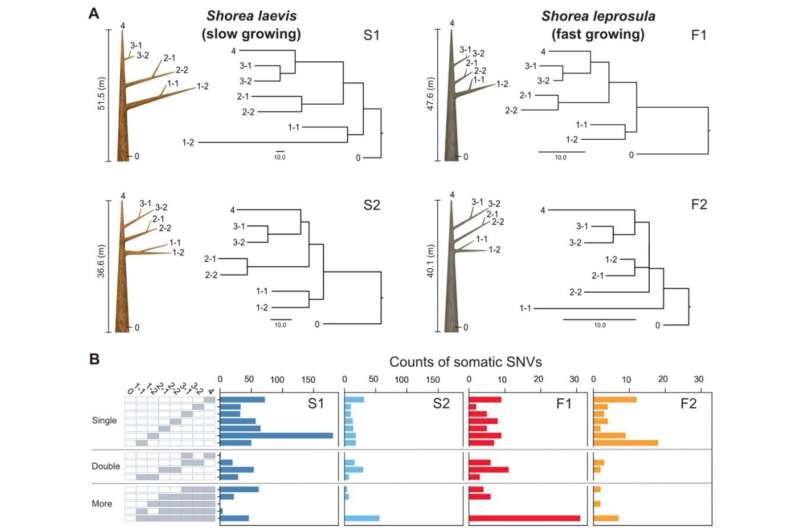Study suggests long-lived tree species play greater role in generating genetic diversity

A study of the relationship between the growth rate of tropical trees and the frequency of genetic mutations they accumulate suggests that older, long-lived trees play a greater role in generating and maintaining genetic diversity than short-lived trees.
The study, published today as a Reviewed Preprint in eLife, provides what the editors describe as compelling evidence that tree species acquire mutations at a similar yearly rate, independent of cell division and regardless of their growth rate.
The findings may be used to inform ecosystem conservation strategies, particularly in the tropical forests of southeast Asia, which are under threat from climate change and deforestation.
“Biodiversity ultimately results from mutations that provide genetic variation for organisms to adapt to their environment,” explains co-lead author Akiko Satake, a Professor in the Department of Biology, Faculty of Science, Kyushu University, Japan. “However, how and when these mutations occur in natural environments is poorly understood.”
Somatic mutations are spontaneous changes in an organism’s DNA that occur during its lifespan. They can arise due to external factors such as ultraviolet radiation, or internal factors such as DNA replication errors. It is not clear which of these factors causes mutations more frequently, particularly in tropical ecosystems and trees, which are not as well characterized as their more temperate counterparts.
To understand this better, Satake and colleagues examined the rates and patterns of somatic mutations in two species of tropical trees native to central Borneo, Indonesia: the slow-growing Shorea laevis (S. laevis), and the fast-growing S. leprosula. The species S. leprosula grows more than three times faster than S. laevis.
Comparing the somatic mutations of the two tree species allowed the team to gain insights into the impact of growth rate on the accumulation of these mutations, and its potential role in driving evolution and species diversity.
They collected seven DNA samples from the leaves at the highest level of the tree branches, as well as samples from the trunk of each tree, totaling 32 samples. The length and diameter of the trees at breast height was used to determine the average age of each species in the sampling area. S. laevis trees were on average 256 years old, whereas S. leprosula trees were on average 66 years old.
To identify the mutations present, the team constructed a reference genetic dataset for each tree species, using the DNA collected from the leaves. The genome sequence was determined using a technique called long-read PacBio RS II and short-read Illumina sequencing. The team extracted DNA twice from each sample, allowing them to pinpoint single nucleotide variants (SNVs) within the same individual by identifying those that were identical between the two samples.
The majority of mutations were found to be present within a single tree branch. However, some mutations were found across multiple branches, implying that they had been transmitted between branches at some point during the tree’s growth.
In both species, the team noticed a linear increase in the number of mutations with physical distance between branches. The rate of mutations per meter was on average 3.7 times greater in the slow-growing S. leavis than in the fast-growing S. leprosula, suggesting that slow-growing trees accumulate more somatic mutations.
However, when accounting for the differences in growth rates, and calculating the rate of mutations per year, the two species had equal rates. This finding suggests that somatic mutations accumulate in a clock-like manner as a tree ages, independent of DNA replication and growth rate.
“We also found that somatic mutations are neutral within an individual—that is, they are neither beneficial nor detrimental to survival. However, those mutations transmitted to the next generation are subject to strong natural selection during seed germination and growth,” says co-lead author Ryosuke Imai, Post-doctoral Fellow in the Department of Biology, Faculty of Science, Kyushu University.
“This suggests that somatic mutations accumulate with time, and older trees contribute more towards generating genetic variation and adaptation to their environment, thereby increasing the chances of their species’ survival.”
Imai and colleagues encourage further research into this area. In particular, they say that mathematical modeling would be required to consider the asymmetric division of cells during elongation and branching in order to further validate the findings.
“In trees, somatic mutations can be transmitted to seeds, resulting in rich genetic variations within subsequent generations,” states one of the author Masahiro Kasahara, Associate Professor in the department of computational biology and medical sciences, the University of Tokyo, Japan. “As the tropical rainforests of southeast Asia face the threats of climate change and deforestation, our study suggests that long-lived trees may play a crucial role in maintaining and increasing the genetic variation of these tropical systems.”
More information:
Ryosuke Imai et al, The molecular clock in long-lived tropical trees is independent of growth rate, eLife (2023). DOI: 10.7554/eLife.88456.1
Citation:
Study suggests long-lived tree species play greater role in generating genetic diversity (2023, June 6)
retrieved 7 June 2023
from https://phys.org/news/2023-06-long-lived-tree-species-play-greater.html
This document is subject to copyright. Apart from any fair dealing for the purpose of private study or research, no
part may be reproduced without the written permission. The content is provided for information purposes only.
For all the latest Science News Click Here
For the latest news and updates, follow us on Google News.

